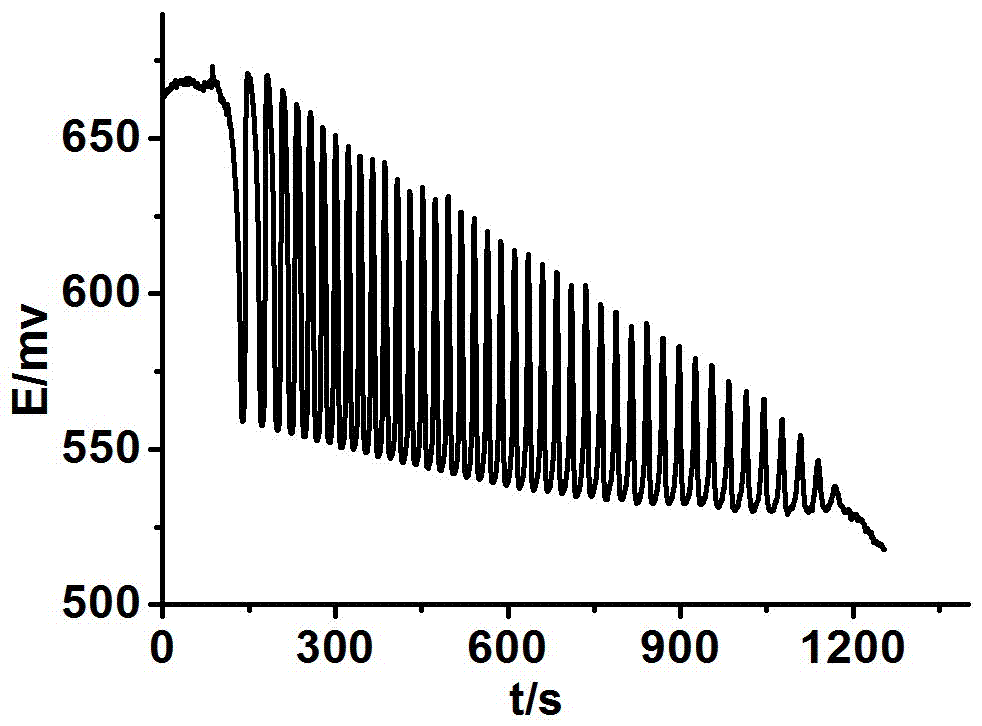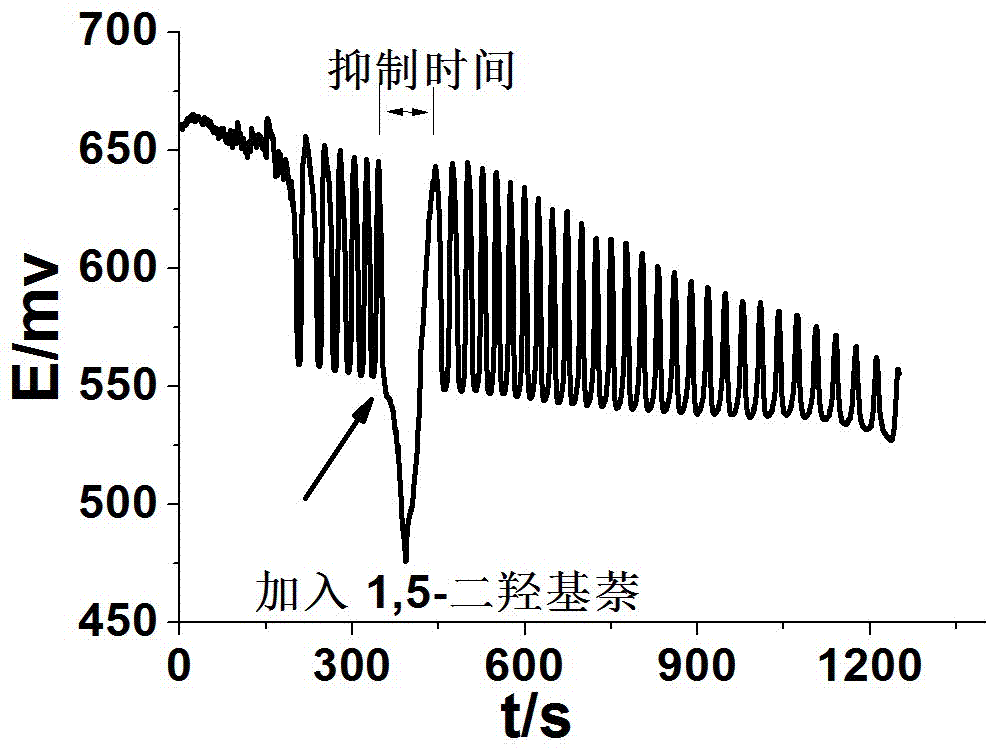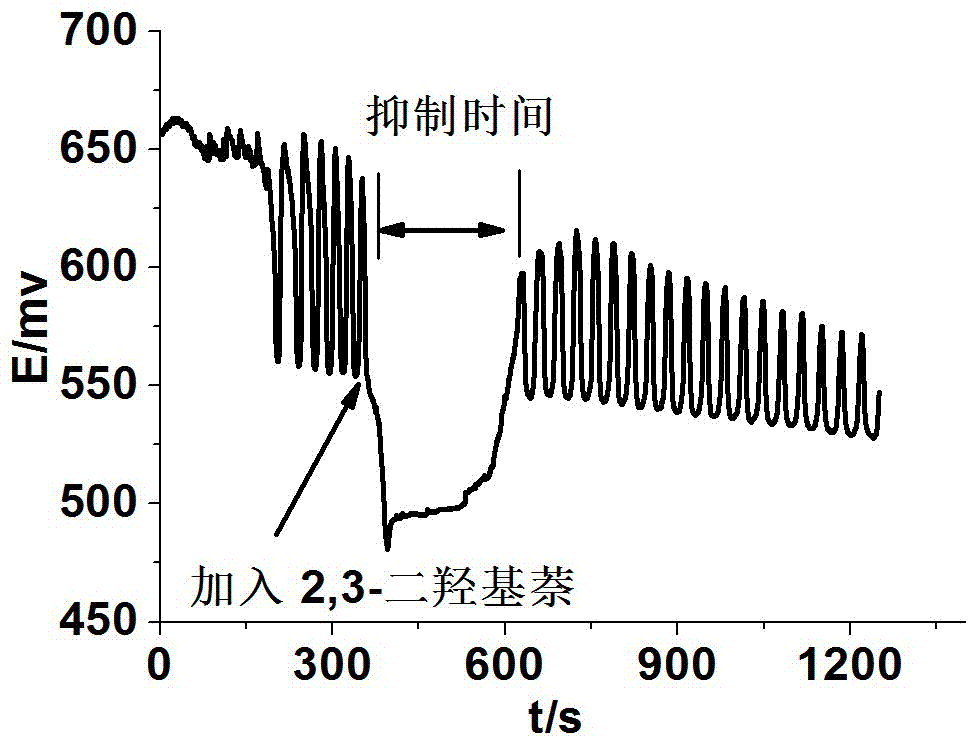Method for identifying four kinds of dioxynaphthalene isomeride
A technology of isomers and dihydroxynaphthalene, which is applied in the field of identification, can solve the problems that the identification has not yet been reported.
- Summary
- Abstract
- Description
- Claims
- Application Information
AI Technical Summary
Problems solved by technology
Method used
Image
Examples
Embodiment 1
[0054] This example verifies the four dihydroxynaphthalene isomers 1,5-dihydroxynaphthalene, 2,3-dihydroxynaphthalene, 2,7-dihydroxynaphthalene and 1,4-dihydroxynaphthalene according to the following steps The feasibility of the identification method:
[0055] (1) Preparation solution
[0056] First use 98% concentrated sulfuric acid and distilled water to prepare 0.025mol / L sulfuric acid as a stock solution, then use 0.025mol / L sulfuric acid solution as a solvent to prepare 0.15mol / L potassium iodate solution and 0.017mol / L [NiL ](ClO 4 ) 2 Solution, 2mol / L malonic acid solution, 4mol / L hydrogen peroxide solution.
[0057] At the same time, using absolute ethanol as a solvent, prepare 0.05 mol / L solutions of 1,5-dihydroxynaphthalene, 2,3-dihydroxynaphthalene, 2,7-dihydroxynaphthalene and 1,4-dihydroxynaphthalene, respectively.
[0058] (2) Oscillation spectrum
[0059] Add magnetons to a 50mL small beaker, then add 15.5mL 0.025mol / L sulfuric acid solution, 5.5mL 0.15mol / ...
Embodiment 2
[0071] This example verifies the four dihydroxynaphthalene isomers 1,5-dihydroxynaphthalene, 2,3-dihydroxynaphthalene, 2,7-dihydroxynaphthalene and 1,4-dihydroxynaphthalene according to the following steps The feasibility of the identification method:
[0072] (1) Preparation solution
[0073] First use 98% concentrated sulfuric acid and distilled water to prepare 0.025mol / L sulfuric acid as a stock solution, then use 0.025mol / L sulfuric acid solution as a solvent to prepare 0.15mol / L potassium iodate solution and 0.017mol / L [NiL ](ClO 4 ) 2 Solution, 2mol / L malonic acid solution, 4mol / L hydrogen peroxide solution.
[0074] At the same time, using absolute ethanol as a solvent, prepare 0.075 mol / L solutions of 1,5-dihydroxynaphthalene, 2,3-dihydroxynaphthalene, 2,7-dihydroxynaphthalene and 1,4-dihydroxynaphthalene, respectively.
[0075] (2) Oscillation spectrum
[0076] Add magnetons to a 50mL small beaker, then add 15mL 0.025mol / L sulfuric acid solution, 6mL 0.15mol / L p...
Embodiment 3
[0088] This example verifies the four dihydroxynaphthalene isomers 1,5-dihydroxynaphthalene, 2,3-dihydroxynaphthalene, 2,7-dihydroxynaphthalene and 1,4-dihydroxynaphthalene according to the following steps The feasibility of the identification method:
[0089] (1) Preparation solution
[0090] First use 98% concentrated sulfuric acid and distilled water to prepare 0.025mol / L sulfuric acid as a stock solution, then use 0.025mol / L sulfuric acid solution as a solvent to prepare 0.15mol / L potassium iodate solution and 0.017mol / L [NiL ](ClO 4 ) 2 Solution, 2mol / L malonic acid solution, 4mol / L hydrogen peroxide solution.
[0091] At the same time, using absolute ethanol as a solvent, prepare 0.1 mol / L solutions of 1,5-dihydroxynaphthalene, 2,3-dihydroxynaphthalene, 2,7-dihydroxynaphthalene and 1,4-dihydroxynaphthalene.
[0092] (2) Oscillation spectrum
[0093] Add magnetons to a 50mL small beaker, then add 15.5mL 0.025mol / L sulfuric acid solution, 5.5mL 0.15mol / L potassium iod...
PUM
 Login to View More
Login to View More Abstract
Description
Claims
Application Information
 Login to View More
Login to View More - R&D
- Intellectual Property
- Life Sciences
- Materials
- Tech Scout
- Unparalleled Data Quality
- Higher Quality Content
- 60% Fewer Hallucinations
Browse by: Latest US Patents, China's latest patents, Technical Efficacy Thesaurus, Application Domain, Technology Topic, Popular Technical Reports.
© 2025 PatSnap. All rights reserved.Legal|Privacy policy|Modern Slavery Act Transparency Statement|Sitemap|About US| Contact US: help@patsnap.com



